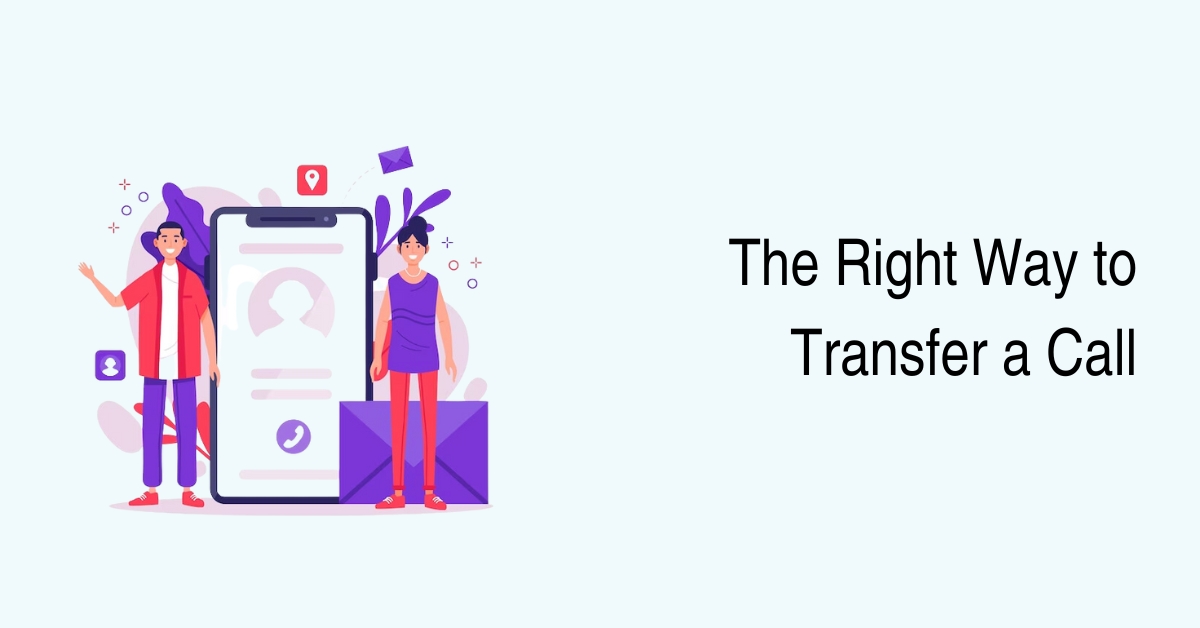In any business that regularly deals with frequent phone calls, call transfers become inevitable. Whether due to call volume or a customer’s specific needs, directing them to a more suitable team member becomes necessary.
Picture this: you’re on a call with a customer, you’ve done your part well, but now it’s time to redirect them to another department or colleague. Seems simple enough, right? Well, not quite. How you handle this transition can make or break the customer experience.
This blog post will provide a step-by-step guide on how to transfer a call the right way. From understanding when to transfer a call to the etiquettes that can transform a frustrating transfer into a positive interaction, we’ll cover it all. So, let’s dive in and learn how to transfer a call like a pro.
Common Challenges in Call Transfers

Transferring calls is a staple in customer service, yet it’s fraught with obstacles that can frustrate callers and staff alike. When the call transfer procedure isn’t executed correctly, the fallout can be significant.
Let’s dive into the common challenges that organisations face during this seemingly simple process.
-
Miscommunication
Smooth call transfers hinge on clear communication. Without it, the entire process of effective call routing falls apart. Agents must understand how to transfer a call the right way—providing the necessary information to the next representative for continuity and customer awareness.
Failure to do so can lead to confusion, repeated information, and, ultimately, a breach of trust.
-
Dropped Calls
A dropped calls are the pitfalls of call transfer procedures. It’s an abrupt end to a customer’s dialogue—often one they’ve invested time in. Robust infrastructure and agent training can mitigate this issue, maintaining the link between initial contact and resolution.
-
Extended Hold Times
Long hold times can test the patience of even the most understanding customer. Efficient routing significantly cuts wait times, improves the customer experience, and reflects your company’s operational efficiency and dedication to its clients.
The Right Way to Transfer a Call

Call transferring is more than just pushing buttons; it’s about routing calls efficiently without making the caller feel like just another number. Mastering how to transfer a call the right way involves a step-by-step call guide that centers on caller satisfaction.
This section takes a straightforward approach to call redirection methods to showcase your company’s prowess in communication.
-
Active Listening
Active listening means listening with the intent to solve problems. It’s the cornerstone of successful call handling—fully concentrating on the caller, understanding their needs, and acknowledging their request. This initial step sets the groundwork for a seamless telephone call transfer.
-
Gathering Necessary Information
Before initiating a call transfer, gather all necessary information. Confirming these details will assist the next representative in handling the customer effectively. It’s a proactive step that can significantly streamline the call redirection methods, reducing the need for repeated information and multiple transfers.
-
Informing the Caller
When informing the caller about the transfer, make sure you stay transparent. Explain the ‘how’ and ‘why’ behind the action, using clear and straightforward language.
Letting them know who they’ll speak to next and why it benefits them can make the transfer feel like a step forward in resolving their issue.
-
Confirming the Transfer
Before you hit the transfer button, confirm with the caller. This final step in call transferring ensures they’re prepared and they understand what comes next. This simple yet vital part helps show respect while providing reassurance that their call matters, even after it’s passed to another person.
Implementing Technology for Seamless Transfers
Directing calls properly depends on making the most out of innovative technology like automatic call distribution (ACD) systems, which simplify the call forwarding process, reduce wait times, and boost overall customer satisfaction.
Incorporating tools for call redirection like caller ID and intelligent routing helps identify and direct callers to the appropriate department or agent. Now, the best call transfer tips boils down to two things: speed and accuracy. Speed, because being able to tend to an issue quickly is essential to customer satisfaction; accuracy, because no one likes to land in the wrong queue.
Training for Call Center Agents

Extensive training provides call center agents with the skills to handle calls proactively, ensuring customers walk away satisfied. A well-prepared agent is the backbone of a successful call center operation, which is why training should be comprehensive, covering everything from basic communication skills to complex problem-solving.
-
Communication Skills
Good communication is chapter one in improving call handling. Training should focus on clear articulation, active listening, and empathy. Agents need to understand customer needs quickly and offer solutions without lag, ensuring that enhancing customer calls becomes second nature during their interactions.
Role-playing exercises and real-case simulations can be invaluable tools for practicing these skills and enhancing their application in actual scenarios.
-
System Proficiency
Call management tactics extend beyond conversation to system navigation. Agents must excel in using call center software to log calls, access data, and manage information.
Practical training sessions focusing on software functionalities and simulations of various call scenarios help agents become adept at system navigation. It equips them with the know-how to handle any call transfer swiftly and accurately.
-
Handling Difficult Scenarios
Dealing with challenging situations demands a composed and solution-focused approach. Training programs should equip agents with strategies to de-escalate tense scenarios, resolve issues, and turn negative experiences into positive ones.
Role-playing exercises involving challenging customer scenarios and guidance on conflict resolution techniques are invaluable in preparing agents to handle real-life challenging calls with finesse and professionalism.
Monitoring and Improving Transfer Metrics
Efficient call transfer solutions involve constant monitoring and improvement of transfer metrics. To learn how to transfer a call the right way, remember to keep a close eye on key performance indicators.
Metrics like transfer completion time, customer satisfaction post-transfer, and the frequency of successful transfers provide valuable insights. Regularly assessing these metrics allows businesses to identify areas for improvement and refine their call transfer strategies.
Customer Experience Enhancement

Businesses must be agile and innovative, ensuring that every interaction is smooth and every resolution is swift. Refining the customer journey at every touchpoint allows companies to build loyalty, improve satisfaction, and drive growth.
-
Minimising Wait Times
Optimising call transfer starts with reducing wait times. Implementing call routing tried-and-tested methods and streamlining transfer processes helps customers quickly reach their intended destination, ensuring that no customer is left waiting and that their time is respected.
-
Providing Personalised Assistance
Standing out in a crowded marketplace depends on how well you provide callers with personalised assistance. Customer data and preferences can aid representatives in tailoring their support, making each interaction feel unique and valued.
Giving personalised greetings and directing calls to preferred agents shows that your business understands and remembers the customer’s needs.
-
Follow-up Procedures
The customer’s journey doesn’t end with the initial interaction. Follow-up procedures post-transfer, such as feedback requests or callbacks, demonstrate commitment to resolving issues completely. It’s a way of showing commitment beyond the initial call to foster customer loyalty and satisfaction.
Bottom Line
Mastering how to transfer a call the right way is essential in providing top-tier customer service and maintaining the professionalism of your business. For businesses in Melbourne, VIC, looking to implement these practices with advanced technology, VoIPElements offers a robust solution. Their state-of-the-art VoIP services streamline the call-transferring process and equip your team with the tools to handle calls successfully and with ease.
With VoIPElements, you can trust that every call transfer is executed flawlessly, leaving your callers with a positive impression of your company’s commitment to exceptional customer service.


